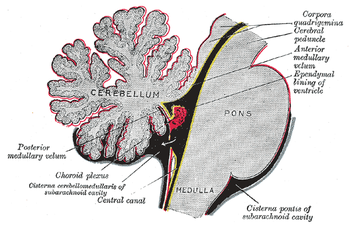Albright's hereditary osteodystrophy
| Albright's hereditary osteodystrophy | |
|---|---|
 | |
| Albright's hereditary osteodystrophy has an autosomal dominant pattern of inheritance | |
| Specialty | Endocrinology |
| Symptoms | Choroid plexus calcification, Full cheeks[1] |
| Causes | Gs alpha subunit deficiency[2] |
| Diagnostic method | calcium, phosphorus, PTH, Urine test for phosphorus and cyclic AMP |
| Treatment | Phosphate binders, supplementary calcium [3] |
| Named after | Fuller Albright |
Albright's hereditary osteodystrophy is a form of osteodystrophy,[4] and is classified as the phenotype of pseudohypoparathyroidism type 1A; this is a condition in which the body does not respond to parathyroid hormone.[1]
Signs and symptoms

The disorder is characterized by the following:[1]
- Hypogonadism
- Brachydactyly syndrome
- Choroid plexus calcification
- Hypoplasia of dental enamel
- Full cheeks
- Hypocalcemic tetany
Individuals with Albright hereditary osteodystrophy exhibit short stature, characteristically shortened fourth and fifth metacarpals, rounded facies, and often mild intellectual deficiency.[5]
Genetics
This condition is associated with genetic imprinting. It is thought to be inherited in an autosomal dominant pattern, and seems to be associated with a Gs alpha subunit deficiency.[2]
Mechanism
The mechanism of this condition is due to Gs signaling decrease in hormones having to do with signal transduction which is when a signal from outside cell causes change within the cell (in function). Renal tubule cells only express maternal alleles (variant form of a gene).[6][7][8]
Diagnosis
The diagnosis of Albright's hereditary osteodystrophy is based on the following exams below:[9]
Treatment
Treatment consists of maintaining normal levels of calcium, phosphorus, and vitamin D. Phosphate binders, supplementary calcium and vitamin D will be used as required.[3]
History
The disorder bears the name of Fuller Albright, who characterized it in 1942.[12] He was also responsible for naming it "Sebright bantam syndrome," after the Sebright bantam chicken, which demonstrates an analogous hormone insensitivity. Much less commonly, the term Martin-Albright syndrome is used, this refers to Eric Martin.[13]
See also
References
![]() This article incorporates text in the public domain from page 798 of the 20th edition of Gray's Anatomy (1918)
This article incorporates text in the public domain from page 798 of the 20th edition of Gray's Anatomy (1918)
- ^ a b c "Albright's hereditary osteodystrophy". Genetic and Rare Diseases Information Center (GARD) – an NCATS Program. Archived from the original on 11 February 2017. Retrieved 9 February 2017.
- ^ a b Kottler, Marie (2004). "Alpha hereditary Osteodystrophy" (PDF). Orphanet. Archived (PDF) from the original on 2021-04-26. Retrieved 2017-02-12.
- ^ a b Kliegman, Robert (2016). Nelson Textbook of Pediatrics. 20th ed. Philadelphia, PA: Elsevier. pp. chap 572. ISBN 978-1-4557-7566-8.
- ^ Rapini, Ronald P.; Bolognia, Jean L.; Jorizzo, Joseph L. (2007). Dermatology: 2-Volume Set. St. Louis: Mosby. p. 657. ISBN 978-1-4160-2999-1.
- ^ Garavelli L; Pedori S; Zanacca C; et al. (April 2005). "Albright's hereditary osteodystrophy (pseudohypoparathyroidism type Ia): clinical case with a novel mutation of GNAS1". Acta Biomed. 76 (1): 45–8. PMID 16116826.
- ^ "OMIM Entry - # 103580 - PSEUDOHYPOPARATHYROIDISM, TYPE IA; PHP1A". omim.org. Archived from the original on 18 January 2017. Retrieved 12 February 2017.
- ^ Cooper, Geoffrey M (2000). "Pathways of Intracellular Signal Transduction". Sinauer Associates. Archived from the original on 2018-04-05. Retrieved 2024-06-26.
- ^ Reference, Genetics Home. "What is a gene?". Genetics Home Reference. Archived from the original on 2020-05-16. Retrieved 2017-02-12.
- ^ "Pseudohypoparathyroidism: MedlinePlus Medical Encyclopedia". medlineplus.gov. Archived from the original on 13 February 2017. Retrieved 12 February 2017.
- ^ "Pseudohypoparathyroidism". Archived from the original on 2017-02-13. Retrieved 2017-02-12.
- ^ Tze, W. J.; Saunders, J.; Drummond, G. I. (1975). "Urinary 3'5' cyclic AMP. Diagnostic test in pseudohypoparathyroidism". Arch Dis Child. 50 (8): 656–658. doi:10.1136/adc.50.8.656. PMC 1545541. PMID 173244.
- ^ F. Albright, C. H. Burnett, P. H. Smith, et al. Pseudo-hypoparathyroidism-example of 'Seabright-Bantam syndrome'; report of three cases. Endocrinology, Baltimore, 1942, 30: 922-932.
- ^ D. Martin, J. Bourdillon. Un cas de tétanie idiopathique chronique. Échec thérapeutique de la graffe d'un adénome parathyroïdien. Revue médicale de la Suisse romande, Lausanne, 1940, 60: 1166-1177.
Further reading
- Thakker, Rajesh V.; Whyte, Michael P.; Eisman, John; Igarashi, Takashi (2013). Genetics of Bone Biology and Skeletal Disease. Academic Press. ISBN 9780123878304. Retrieved 12 February 2017.
- Henderson, Katherine E.; Baranski, Thomas J.; Bickel, Perry E.; Clutter, William E. (2009). The Washington Manual Endocrinology Subspecialty Consult. Lippincott Williams & Wilkins. ISBN 9780781791540. Retrieved 12 February 2017.
